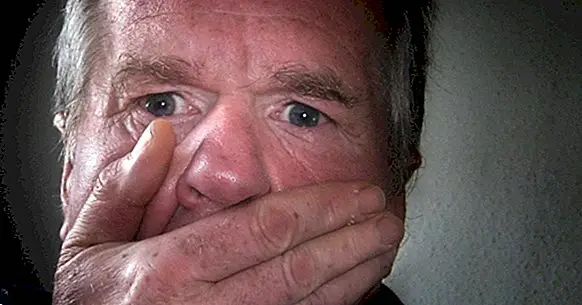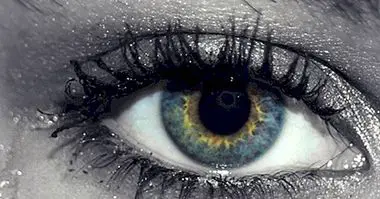Panophobia: symptoms and treatment of this curious type of phobia
We are all afraid of something in this life. In some cases, even this fear comes to take the form of an authentic phobia that can limit us more or less and that can be directed towards some concrete stimulus or not. Spiders, heights, blood or injections, public speaking, closed spaces, airplanes or the impossibility of being helped if we have an anxiety crisis are some typical examples of phobias.
But now imagine that everything scared us. That we were constantly afraid that something would happen. It's what happens to those people who present panophobia or omniphobia .
- Related article: "Types of phobias: exploring the disorders of fear"
Panophobia: the fear of everything
Panophobia or omniphobia is understood as a type of phobia that is somewhat particular. In fact, it can be considered one of the strangest types of phobia. And is that phobias usually refer to the existence of a high level of fear or panic towards a stimulus or type of specific stimulation that is recognized as irrational and disproportionate in relation to the level of real risk involved in the stimulus in question . The presence of the stimulus in question generates a high level of anxiety, to the point that the subject avoids the situations in which it can appear and avoids its appearance.
However, although in panophobia, if we find the previous reactions, the truth is that there is no concrete stimulus to provoke them . Or rather, everything becomes phobic. We would be faced with a sense of panic and terror, continued and vague, without a fixed object that explains it, that remains continuous in time.
Likewise, it is also possible to observe a fluctuation of fear between different stimuli, passing ones to be more phobic than others depending on the situation. Panophobia is not currently recorded as a phobia in diagnostic classifications such as the Diangostic and Statistical Manual of Mental Disorders (or DSM) or the International Classification of Diseases (ICD), but could enter the category of other unspecified anxiety disorders .
- Maybe you're interested: "Types of Anxiety Disorders and their characteristics"
Interference in daily life and in the body
If a specific and specific phobia can become very disabling, it is clear that panophobia carries a high level of suffering, frustration and fatigue to those who suffer from it. It also has the potential to generate an alteration in all vital areas: the person may be afraid of everything he perceives, both from the outside world and from within, and tend to suffer from continued anxiety and isolation. Family, friends, work or leisure are very limited, and the people around the subject may not understand the situation of the person in question.
It is common for depressive symptoms, low self-esteem and self-concept and different somatic alterations to appear over time. On a physical level, the presence of tachycardia, acceleration of cardiorespiratory rhythm, sweating, gastrointestinal complaints , vomiting, headaches, dizziness and fainting are common (as occurs in other phobias against the phobic stimulus). It is necessary to bear in mind that this level of continuous agitation can be harmful for the organism, exhausting our resources and making it difficult to concentrate and maintain energy.
Causes of this disorder
The causes of this disorder are not entirely known, and panophobia is very unusual and there are few studies on it. However, the hypothesis of the existence of a high level of basic brain excitability could be considered, especially in the limbic system, which could have interacted with the presence of multiple traumatic experiences. Over time, the fear generated by such interaction would be generalized to most stimuli , or even capturing reality as something dangerous in its entirety.
Also the conditioning and learning of parental models extremely insecure and with a very high level of anxiety and fear continuously, or with little capacity to provide feelings of security or affection to the child, can contribute to this fact.
Relationship with other psychiatric disorders
Panophobia has often been linked to different, highly known psychiatric conditions. In fact, it is often identified (although it is not exactly the same) with generalized anxiety disorder or GAD, in which persistent agitation and anxiety persist in the face of day-to-day concerns that the subject can not control. whose anticipation he fears (often giving him excessive importance in relation to possible becoming).
Another disorder with which it has been closely linked is with schizophrenia , this fear can appear to everything with the passage of time both in patients with deterioration and in those with a high level of agitation. It is usually a secondary rather than a defining symptom of the disorder.
Finally, it has also been related to borderline personality disorder, characterized by an intense and overflowing emotionality, highly labile and in which those who suffer from it have great difficulties in managing emotions. It is a common symptom the presence of chronic feelings of deep emptiness, as well as despair at the idea of being abandoned and performing different behaviors to avoid it, delusional ideas and aggressive and self-injurious attitudes.
The treatment of panophobia
Taking into account the aforementioned characteristics of panophobia, its treatment may seem more complicated than that of other phobias. But this does not mean that it is not possible to combat this problem.
As with all other phobias, Exposure therapy becomes a really useful technique . However, there is a difficulty: the establishment of an exposure hierarchy. And in this case the phobic stimulus is nonspecific and in many cases patients are not able to determine what they fear. While we usually focus on one type of phobic stimulus, in this case it is much less likely. So in this type of phobia to which the subject in question should be exposed is to the sensation of fear in question, being able to be applied the different fears that go narrating.
Further, systematic desensitization is very useful , in which the subject must learn to emit a behavior incompatible with anxiety or fear. If necessary, in order to facilitate the process and extreme control of exposure conditions, exposure in virtual reality may be used.
Cognitive restructuring is another of the most used techniques and can be very useful. Explain the beliefs of the subject about himself, with respect to the world and their situation to try later to propose alternative interpretations and gradually integrate them into the psyche of the patient can allow a better self-control and over time a lower level of nervous activation .
Neurolinguistic programming and the technique of self-instruction can also be helpful, so that by reprogramming how we express ourselves and the self-instructions we give ourselves, we can visualize ourselves from a more positive and self-effective perspective.
Also the learning of relaxation techniques is important. In extreme cases, even the use of medication may be required in order to control the level of physiological activation, although work must be done to explore the origin that such fear may have and perform therapies such as those mentioned above.



















